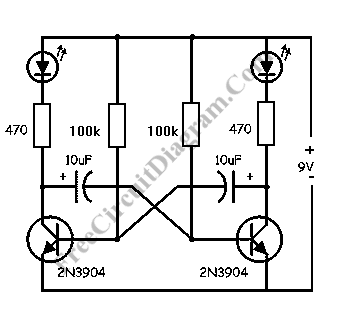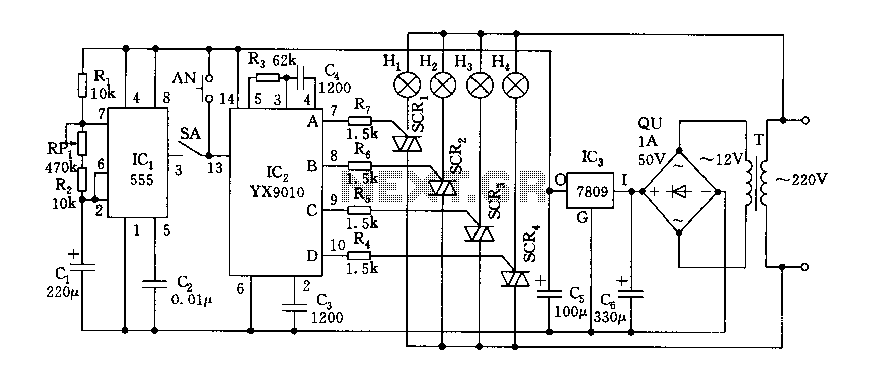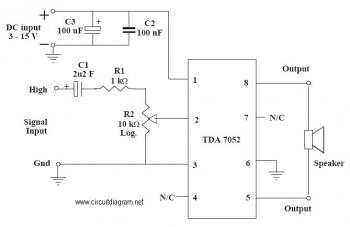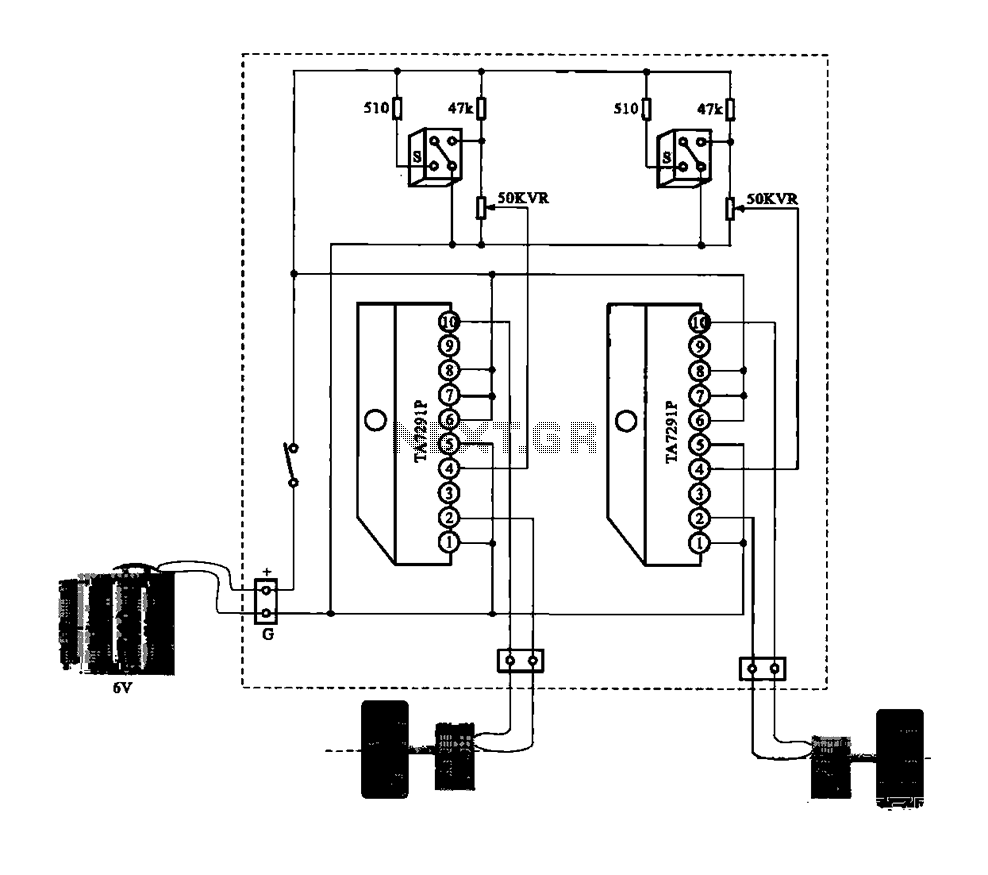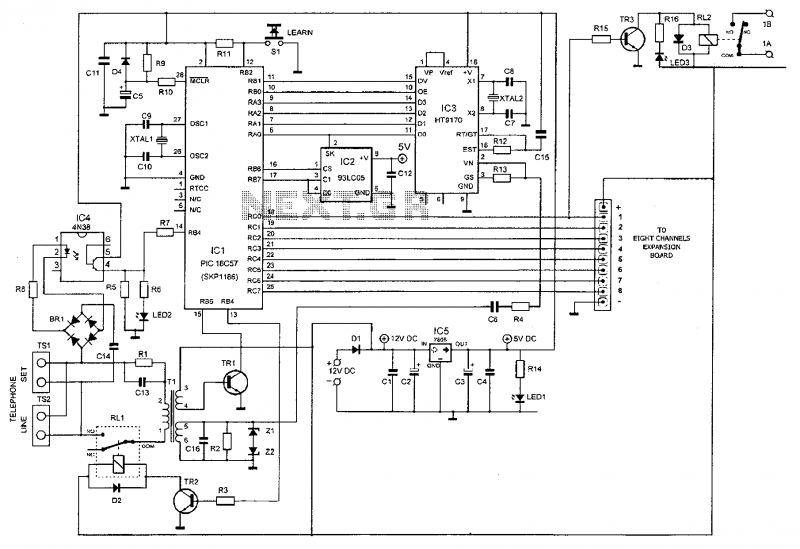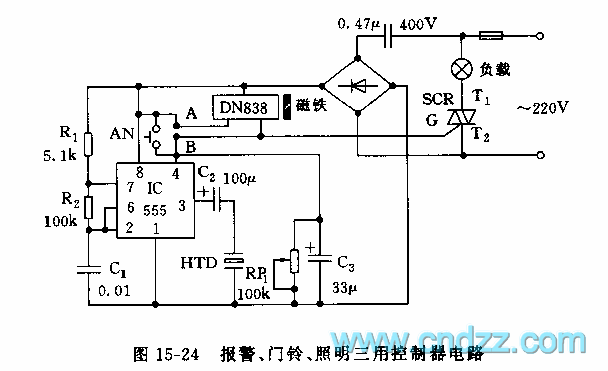
FM IF MW radio receiver circuit using LA1260 integrated circuit
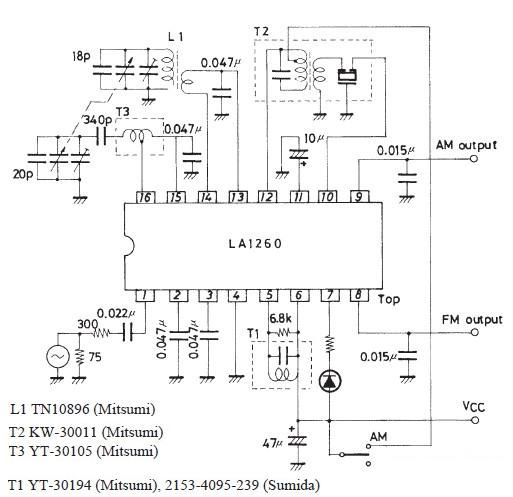
This FM IF MW radio receiver circuit schematic utilizes the LA1260 integrated circuit (IC), which is suitable for AM and FM radio receiver electronic projects. The LA1260 incorporates numerous functions and features essential for radio receiver applications, including a high signal-to-noise ratio (S/N) of 81 dB for FM and 53 dB for AM. It features a low-level AM oscillator with automatic level control (ALC) capable of handling medium wave (MW) signals at 130 mV and short wave (SW) signals ranging from 70 mV to 90 mV at 7 MHz and 4 MHz, respectively. The circuit minimizes AM whistle interference, achieving only 1% whistle at an input of 100 dB/m. The LA1260 also includes an on-chip LED tuning indicator driver, an FM/AM selector, and independent output pins for both FM and AM. To maintain optimal performance, the AM local oscillation components, AM local oscillation coil, and antenna circuit elements, such as the bar antenna, should be spatially separated to prevent degradation of quality factors (Qs). Furthermore, pin 16 (AM oscillation injection pin) and pin 14 (RF input pin) must also be kept apart. The recommended power supply for this radio receiver circuit is 4.5 volts DC; however, the LA1260 IC can operate within a voltage range of 3 to 8 volts DC.
The LA1260 IC is designed with a variety of integrated functions that facilitate the construction of efficient radio receivers. The high S/N ratios for both FM and AM ensure clear audio output, making it suitable for various applications. The low-level AM oscillator with ALC is particularly advantageous for maintaining consistent performance across different signal strengths, thereby enhancing the receiver's sensitivity and selectivity.
In terms of circuit design, careful attention must be paid to the layout of the components. The separation of the AM local oscillation parts, including the coil and antenna circuits, is crucial for minimizing interference and ensuring optimal signal processing. This design consideration helps to reduce unwanted noise and maintain the integrity of the received signals.
The inclusion of an on-chip LED tuning indicator provides a visual feedback mechanism, allowing users to easily identify the tuning status of the receiver. This feature enhances usability, particularly in mobile or portable applications where quick adjustments may be necessary.
The FM/AM selector, also integrated within the LA1260, simplifies the design by allowing a single IC to handle both types of modulation, thus reducing the overall component count and complexity of the circuit. The independent output pins for FM and AM further enhance versatility, enabling the use of separate processing stages for each modulation type if desired.
For power supply considerations, the ability of the LA1260 to operate over a range of 3 to 8 volts DC provides flexibility in design, allowing it to be powered by various sources, including batteries or regulated power supplies. This adaptability makes the LA1260 a valuable component in the design of portable radio receivers, where power efficiency and size constraints are often critical factors.
Overall, the LA1260 IC presents a comprehensive solution for AM and FM radio receiver projects, combining high performance with user-friendly features and flexible design options.As you can see in this FM IF MW radio receiver circuit schematic the LA1260 ic can be used in AM FM radio receiver electronic projects. LA1260 has integrated in the package many functions and features that are needed for radio receiver applications.
high S/N : FM 81dB, AM 53dB ;low-level AM oscillator with ALC MW 130mV SW 70 mV to 90 mV (7MHz) (2 4MHz) ;less AM whistle interference : whistle 1% at input 100dB/m. ;on-chip LED tuning indicator driver ;on-chip FM/AM selector; independent FM/AM output pins. The AM local oscillation parts, AM local oscillation coil, and antenna circuit parts such as bar antenna must be separated from each other as far as possible to prevent Qs from worsening. Pin 16 (AM oscillation injection pin) and pin 14 (RF input pin) must be separated from each other. The recommended power supply for this radio receiver circuit is 4. 5 volt DC, but the LA1260 ic accepts an input voltage range from 3 to 8 volts DC. 🔗 External reference
The LA1260 IC is designed with a variety of integrated functions that facilitate the construction of efficient radio receivers. The high S/N ratios for both FM and AM ensure clear audio output, making it suitable for various applications. The low-level AM oscillator with ALC is particularly advantageous for maintaining consistent performance across different signal strengths, thereby enhancing the receiver's sensitivity and selectivity.
In terms of circuit design, careful attention must be paid to the layout of the components. The separation of the AM local oscillation parts, including the coil and antenna circuits, is crucial for minimizing interference and ensuring optimal signal processing. This design consideration helps to reduce unwanted noise and maintain the integrity of the received signals.
The inclusion of an on-chip LED tuning indicator provides a visual feedback mechanism, allowing users to easily identify the tuning status of the receiver. This feature enhances usability, particularly in mobile or portable applications where quick adjustments may be necessary.
The FM/AM selector, also integrated within the LA1260, simplifies the design by allowing a single IC to handle both types of modulation, thus reducing the overall component count and complexity of the circuit. The independent output pins for FM and AM further enhance versatility, enabling the use of separate processing stages for each modulation type if desired.
For power supply considerations, the ability of the LA1260 to operate over a range of 3 to 8 volts DC provides flexibility in design, allowing it to be powered by various sources, including batteries or regulated power supplies. This adaptability makes the LA1260 a valuable component in the design of portable radio receivers, where power efficiency and size constraints are often critical factors.
Overall, the LA1260 IC presents a comprehensive solution for AM and FM radio receiver projects, combining high performance with user-friendly features and flexible design options.As you can see in this FM IF MW radio receiver circuit schematic the LA1260 ic can be used in AM FM radio receiver electronic projects. LA1260 has integrated in the package many functions and features that are needed for radio receiver applications.
high S/N : FM 81dB, AM 53dB ;low-level AM oscillator with ALC MW 130mV SW 70 mV to 90 mV (7MHz) (2 4MHz) ;less AM whistle interference : whistle 1% at input 100dB/m. ;on-chip LED tuning indicator driver ;on-chip FM/AM selector; independent FM/AM output pins. The AM local oscillation parts, AM local oscillation coil, and antenna circuit parts such as bar antenna must be separated from each other as far as possible to prevent Qs from worsening. Pin 16 (AM oscillation injection pin) and pin 14 (RF input pin) must be separated from each other. The recommended power supply for this radio receiver circuit is 4. 5 volt DC, but the LA1260 ic accepts an input voltage range from 3 to 8 volts DC. 🔗 External reference
Warning: include(partials/cookie-banner.php): Failed to open stream: Permission denied in /var/www/html/nextgr/view-circuit.php on line 713
Warning: include(): Failed opening 'partials/cookie-banner.php' for inclusion (include_path='.:/usr/share/php') in /var/www/html/nextgr/view-circuit.php on line 713
